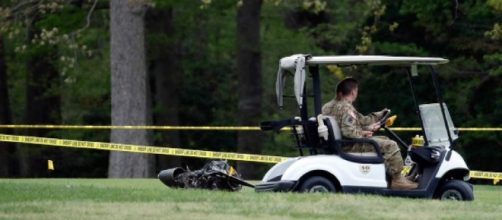The United States Army's 12th Aviation Battalion was conducting a routine training operation in Maryland on Tuesday, April 17, 2017. The Army unit is based out of Davison Airfield in Fort Belvoir, Virginia. Investigators say that three Army crew members were aboard the UH-60—referred to as a Black Hawk, when it spun out of control and crashed.
Reportedly, one crew member was killed and the other two are in serious and critical conditions at a local hospital in Maryland. In response to the black hawk crash, a high-ranking Army military official made a statement.
Major General Bradly A. Becker, United States Army, reports to the community that the Army is deeply saddened by the loss. Major General Becker is the commanding officer for Joint Force Headquarters National Capital Region. He sends his thoughts to the family and friends that are affected by the Army black hawk crash and reassures the community that they have support from the Army.
Black Hawk down
The training exercise, and subsequent crash, reportedly took place at about 1:40 p.m. Several witnesses reported seeing the black hawk spin out of control. Debris was strewn about on the golf course and was coming off of the aircraft as it spun out of control. The witnesses did not report seeing any flames but heard the loud crash.
The two injured Army crew members were last reported as being treated at a trauma center at the University of Maryland Medical Center in Baltimore.
Here's today's @USArmy release on the fatal Black Hawk crash in Maryland. (Corrected news release; I deleted a similar previous tweet.) pic.twitter.com/8Fxv7bLO6r
— Dan Lamothe (@DanLamothe) April 17, 2017
Crash site
The black hawk went down near Leonardtown, about 60 miles southeast of Washington, D.C. Investigators examined the debris which fell near and on the Breton Bay Golf and Country Club. This incident is the second incident in two weeks that the military has had involving an aircraft maintenance failure during a training exercise. An F-16 military jet crashed in a wooded area just outside a suburban Washington neighborhood a few weeks ago.
Reports indicated that the pilot ejected from his jet and was only treated for minor injuries—he was also on a training mission. The cost of military aircraft maintenance failures and training accidents comes at the expense of taxpayers—in all it costs millions of dollars. Mishaps and accidents are reportedly on the rise in all branches.
This poses questions of the military’s overall fleet and maintenance readiness, as well as combat readiness. In a time when our current administration is involved in planning and carrying out global combat operations, the lack of military readiness is rightly in question.

